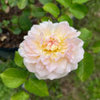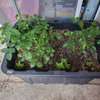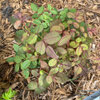Thesis in Portuguese - Biological control - aphids
"ABSTRACT
The rose bush is one of the most cultivated ornamental plants in the world and in Brazil its production and consume also continue to expand. Its cultivation takes place mainly in protected environment aiming at a production of better quality. However, these environments also favour the occurrence of pests which are controlled mostly by the chemical method. The biological control can be an efficient method and undoubtedly it is a more sustainable strategy in management of pests. The coccinellids Cycloneda sanguinea (Linnaeus, 1763) and Eriopis connexa (Germar, 1824) (Coleoptera: Coccinellidae) are generalist predators responsible for reducing populations of arthropod-pest, mainly aphids. These hemipterous are among the main pests of the rose bush and, between the species commonly found in roses cultivation, is found Macrosiphum rosae (Linnaeus, 1758) (Hemiptera: Aphididae). Therefore, this work aimed to evaluate the consumption of M. rosae by C. sanguinea and E. connexa, as well as to provide knowledge about some biological parameters of these predators related to rose bushes. Infested rose bushes leaflets with M. rosae nymphs with standardized age were used, they were kept in Petri dishes (9 cm Ø) upon which the releasing of a newly hatched larva of each of the coccinellids was carried out. Immatures development was followed daily by evaluating the viability and duration of each stage of the development. After emergence couples were formed, which were packed in cylindrical containers (10 x 10 cm) for the assessment of reproductive parameters. Aphids consumption was evaluated in the larval and adult phase of both predators. There was a shorter period of larval development, greater oviposition and longer longevity for C. sanguinea compared to E. connexa. Also, a higher consumption for larvae and adults of C. sanguinea in relation to the second species was found. It was concluded that both predators developed satisfactorily feeding on the aphid M. rosae. Nonetheless, C. sanguinea presented biological characteristics more suitable for use as a biological control agent of this pest in rose bushes. "
http://repositorio.ufla.br/bitstream/1/15251/1/DISSERTA%C3%87%C3%83O_Aspectos%20biol%C3%B3gicos%20e%20consumo%20de%20Cycloneda%20sanguinea%20e%20Eriopis%20connexa%20%28Coleoptera%20Coccinellidae%29%20alimentados%20com%20Macrosiphum%20rosae%20%28Hemiptera%20Aphididae%29%20em%20roseira.pdf








Related Discussions
This companion planting may actually work!
Q
Evil aphids
Q
Squash Vine Borer season-
Q
Russian rose article (thesis)?
Q